

Virtual visits
- Facebook Facebook (opens in a new window)
- Twitter Twitter (opens in a new window)
- Email Email (opens in a new window)
- Link Link Copy
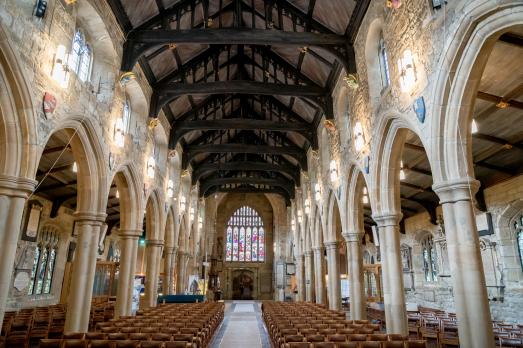
Bradford Cathedral
Bradford's beautiful cathedral is a hidden jewel waiting to be discovered with its peaceful setting in tranquil gardens where once battle raged.
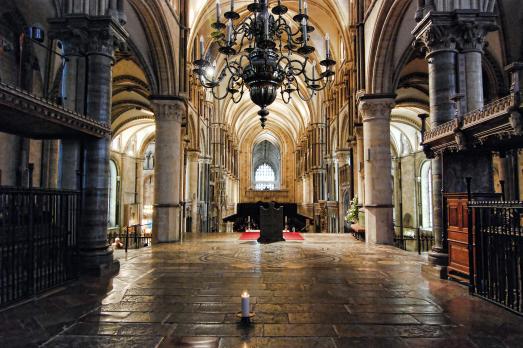
Canterbury Cathedral
The world famous cathedral, housing many stunning features, including a Romanesque crypt, a perpendicular nave and beautiful medieval stained glass windows.
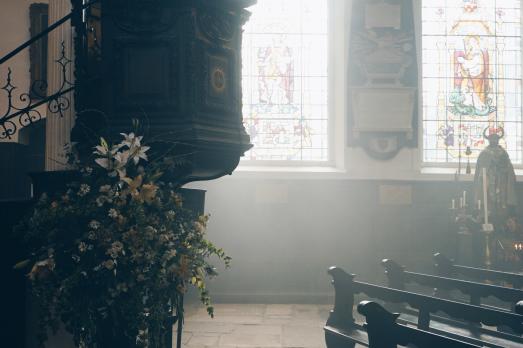
St Magnus the Martyr, City of London
The original church, founded in the early 12th century, was one of the first buildings to be destroyed by the Great Fire as it stood just 300m (1000ft) from Pudding Lane.
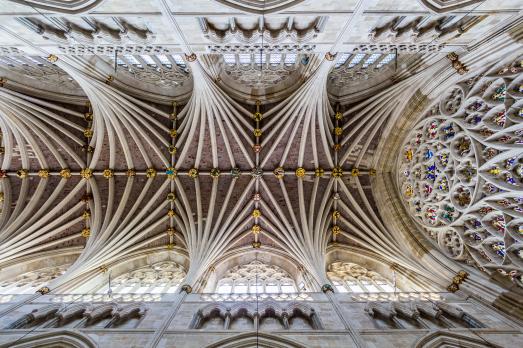
Exeter Cathedral
One of the finest examples of Gothic architecture anywhere: inside you’ll find a building which has lived through war, political unreset, the Exeter Blitz and much more.
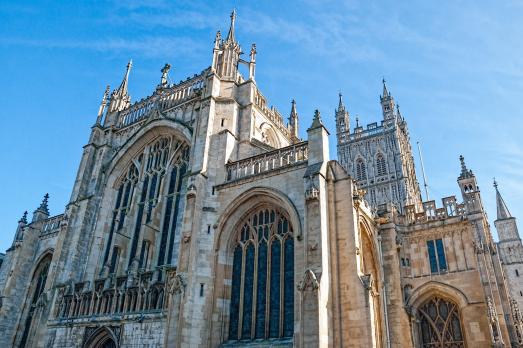
Gloucester Cathedral
Take in the beautifully restored medieval Lady Chapel and our impressive Norman nave, or journey into the crypt below and the tribune gallery above.
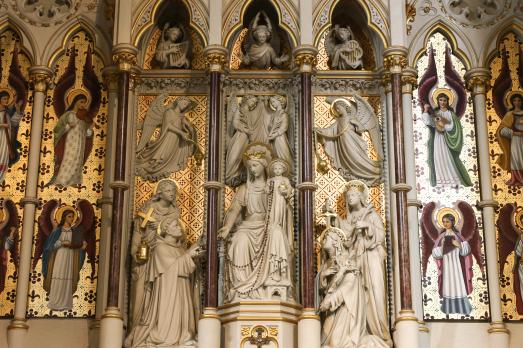
The Rosary Shrine, Haverstock Hill
London's Rosary Shrine is the main church of the Dominican friars in England, completed in 1883 as a unique testimony in stone and glass to the power of the prayer of the Rosary.
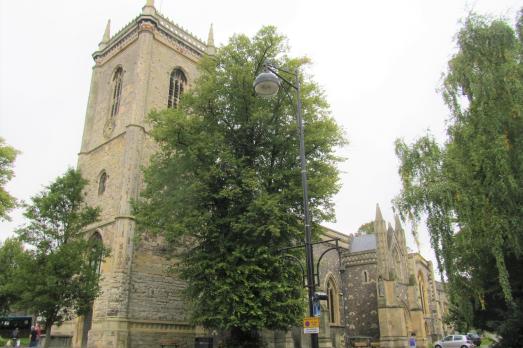
All Saints, High Wycombe
All Saints church is located in the heart of High Wycombe, there has been a church on this site for over 900 years.
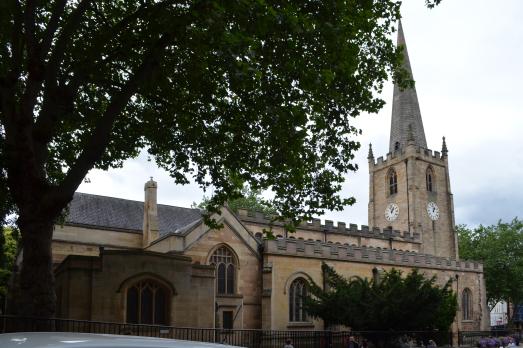
St Peter, Nottingham
An ancient building with several contemporary features, where you will find a remarkable oasis of peace and tranquillity at the heart of Nottingham’s busy life.
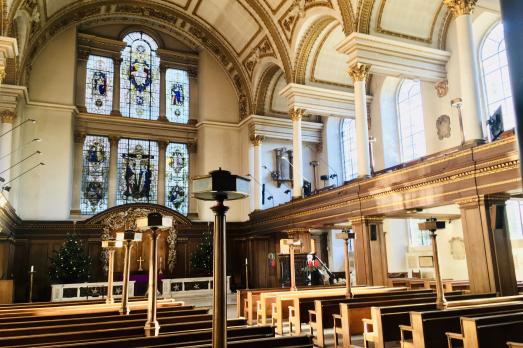
St James, Piccadilly
St James’s church, built by Sir Christopher Wren, was consecrated in 1684, towards the end of the most turbulent century in England’s religious history.
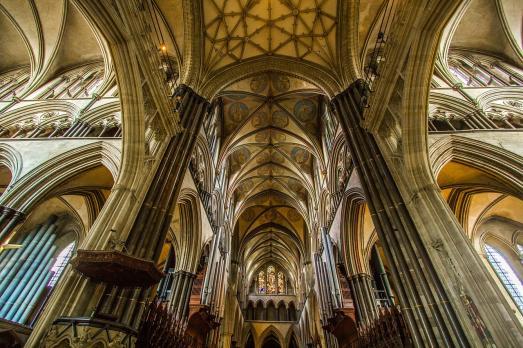
Salisbury Cathedral
This beautiful place welcomed countless visitors for just shy of 800 years, with the best preserved Magna Carta of 1215.
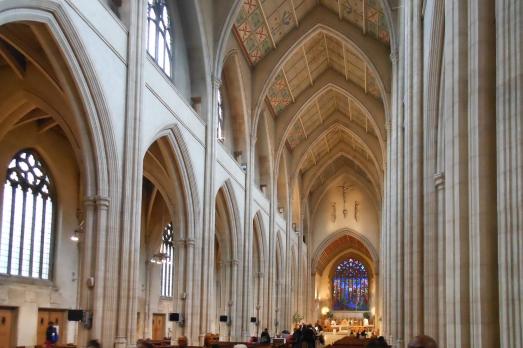
St Georges Cathedral, Southwark
The original cathedral building was designed by the great Victorian architect Augustus Pugin.
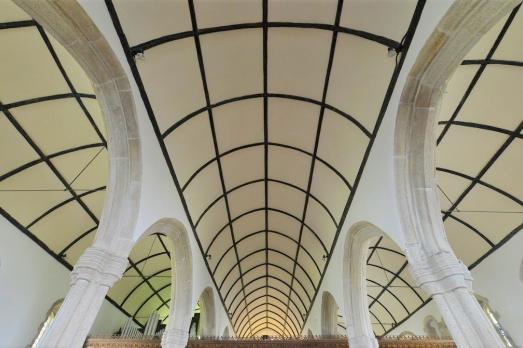
St Buriana, St Buryan
A friendly, Cornish village, dominated by its huge collegiate church, ‘the Cathedral of the West’ dedicated to a 5th century Irish Saint.
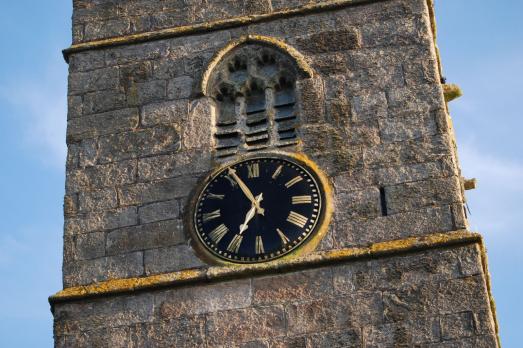
St Just, St Just in Penwith
A fine building located at the very heart of the town, the most westerly town on the mainland of Britain, about seven miles west of Penzance.
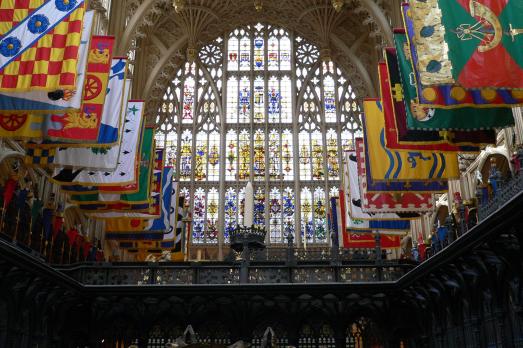
Westminster Abbey
Westminster Abbey presents a unique pageant of British history.
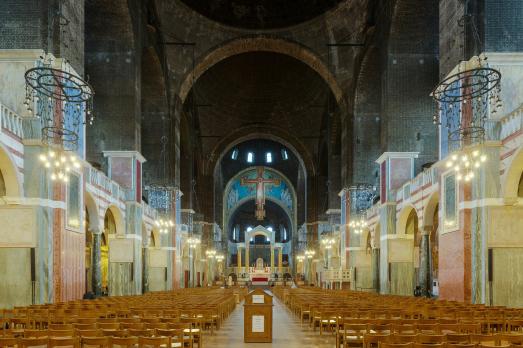
Westminster Cathedral
Westminster Cathedral is a supreme achievement of art with many distinguished works of artistic merit.
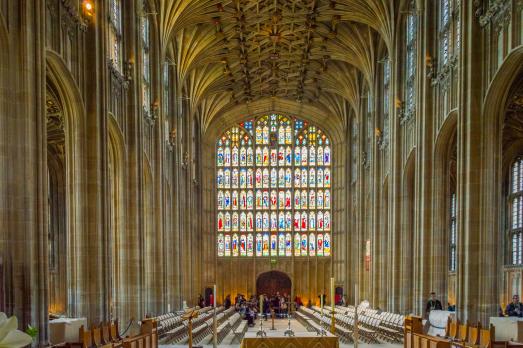
St George’s Chapel, Windsor
The connection with the Royal Family is strong, members have been baptised, marrie
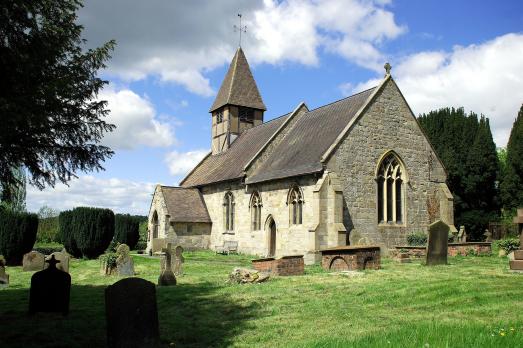
Holy Trinity, Buildwas
Tour our church and churchyard to find out more about a rich history and connections to the world renowned Ironbridge Gorge.
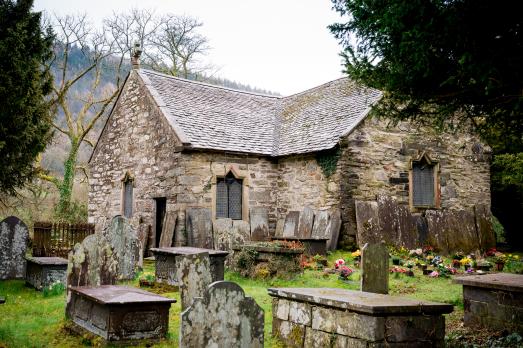
St Michael Old Church, Betws y Coed
This redundant 14th century church is now cared for by the St Michael's Betws y Coed Trust and welcomes visitors from all over the world.
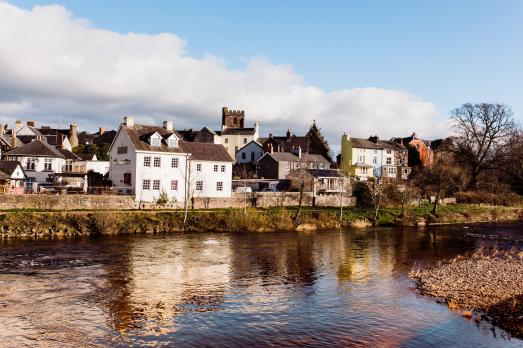
Brecon Cathedral
Brecon Cathedral started life in 1093, built by the Normans on the site of an earlier Celtic church.
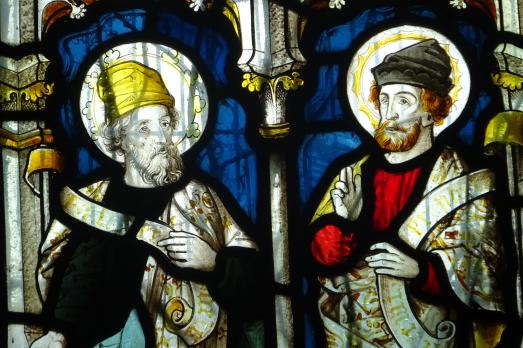
St Mary, Cyfylliog
‘Fylliog church is an ancient, thoroughly restored in the 20th century, set in a quiet and peaceful location nestled beneath trees beside a flowing river, it is an oasis of calm where the spiritual and divine is easy to feel.
St Aelhaiarn, Guilsfield
When the 16th century clerestory was inserted the ceilings were renewed and raised, with snowflake like painted wooden bosses.
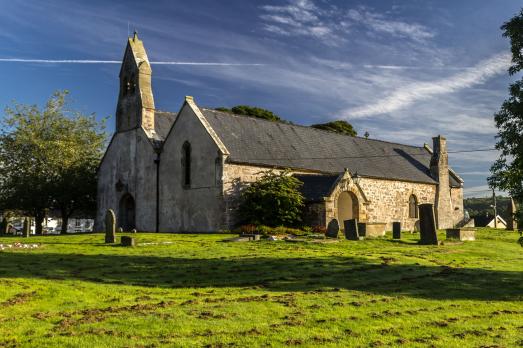
St Garmon, Llanarmon Yn Ial
A veritable treasure trove of hidden history, from pre-reformation chandeliers, effigies of Welsh Princes, ivory states of St Garmon and so much more to explore, all set within a beautiful village, a place of rest and refreshment.
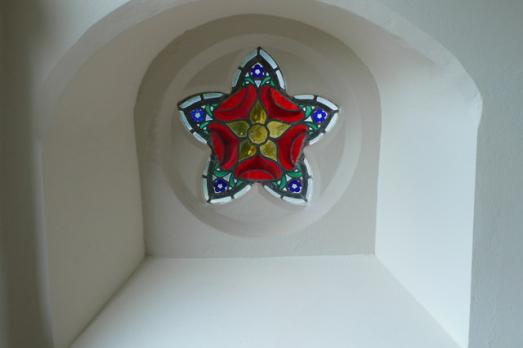
St Peter, Llanbedr Dyffryn Clwyd
Interesting Tractarian church with stunning stained glass windows.
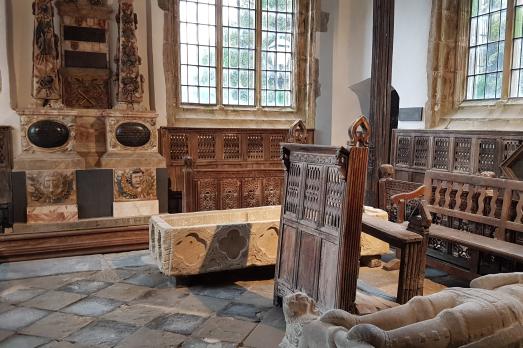
St Grwst, Llanrwst
The walls of St Grwst have seen over 550 years of rich history and religion and are the home to many a story, legend and myth.
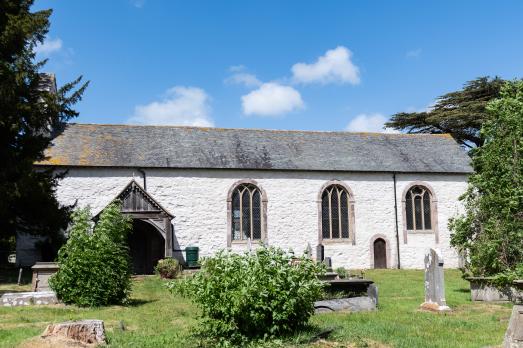
St Saeran, Llanynys
From centuries old graffiti inscribed upon the door to the magnificently preserved medieval wall painting of St Christopher, our history can be read as you journey around this church.
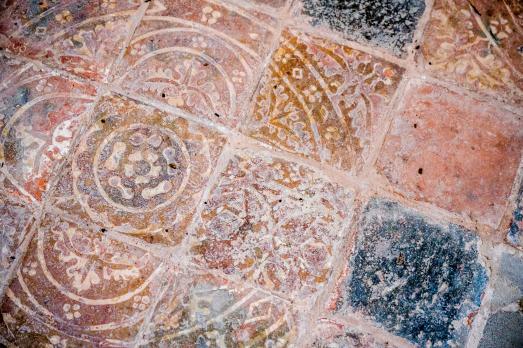
St Peter, Ruthin
Tucked away on one side of the old market square of Ruthin, behind a set of marvellous gilded wrought iron gates.
Northern Ireland
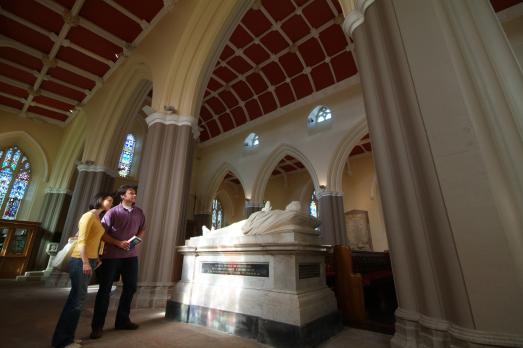
Armagh Cathedral
Many Celtic and medieval carvings are to be seen within the cathedral which is also rich in 18th and 19th century sculpture.
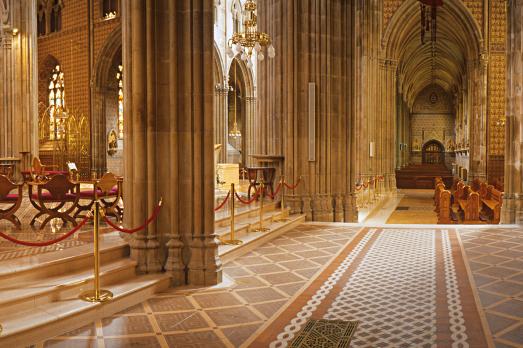
St Patricks Cathedral, Armagh
Built in various phases, the decorative style was significantly changed in 1982 and the beautiful interior is frequently remarked upon by visitors.
St Malachy, Belfast
Designed by Thomas Jackson of Waterford and it is in the ecclesiastical style of the Tudor period and is regarded as one of the finest examples of Tudor Revival style of the churches in Northern Ireland.
Seaman’s Presbyterian Church, Belfast
Step inside Belfast’s dedicated maritime place of worship, which was officially opened in October 1857.
St Nicholas, Carrickfergus
St Nicholas’ Church was established on this site in 1182 by John de Courcy, an Anglo-Norman knight who arrived in Ireland in 1176 and who was responsible for building the impressive Carrickfergus Castle.
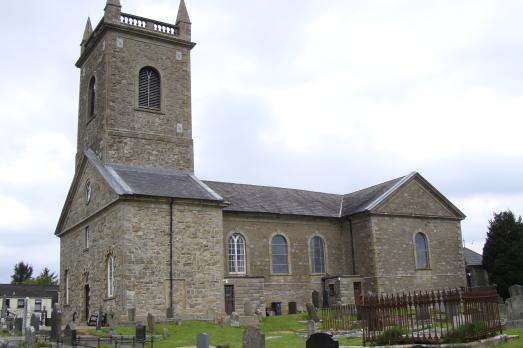
Clogher Cathedral
According to tradition a monastery and bishopric were founded in Clogher circa 490 by St Macartan on the orders of St Patrick.
Devenish Island Monastic Site
Devinish Island is the most important of Lough Erne’s many island church and monastic settlements, and certainly a significant historical site.
First Derry Presbyterian Church
Located within the city’s walls, it is believed to be on the site of an earlier Presbyterian church founded in 1690, as a reward for the bravery of the Presbyterian’s during the Siege of Derry in 1689.
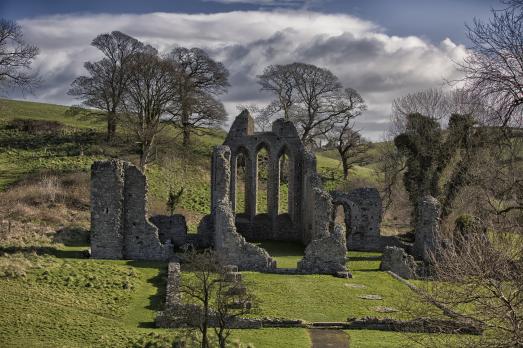
On the north bank of the Quoile River, Inch Abbey was founded by John de Courcy in atonement for his destruction of Erenagah Abbey.
First Presbyterian Non-Subscribing Church, Downpatrick
A large T shaped meeting house opened in 1711 with four galleries including one so called ‘Squires Gallery’ and one gallery approached from an external staircase.
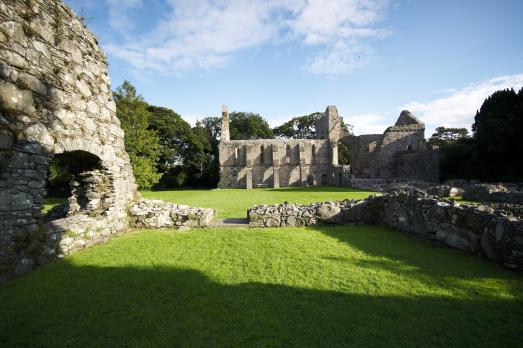
Along with Inch Abbey, Greyabbey is the best example of Cistercian architecture in Ulster and was the daughter house of Holm Cultram in Cumbria.
Holywood Priory
Holywood’s rich ecclesiastical heritage is represented today by its most distinctive building, the Old Priory.
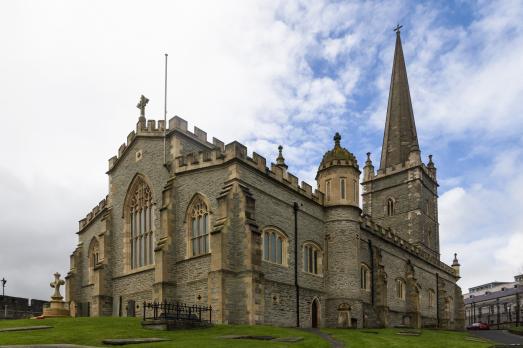

Derry Cathedral, Londonderry
St Columb is the oldest surviving building (1633) in the walled city of Derry, dedicated to Saint Columba, the Irish monk who established a Christian settlement in the area.
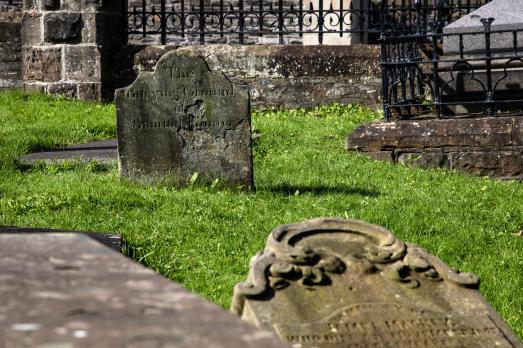
St Augustine, Londonderry
St Augustine's church is known as the 'Wee Church on the Walls' and is thought to be the site of a 6th century monastery.
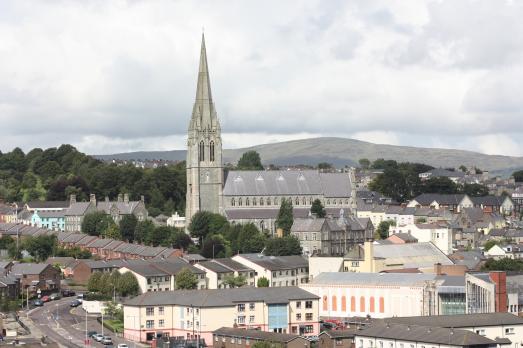
St Eugene's Cathedral, Derry
Between an elegant Georgian district and the green tranquillity of Brooke Park, stands the Catholic cathedral dedicated to St Eugene in 1873 by Bishop Kelly, to whose memory the glass canopy was built.
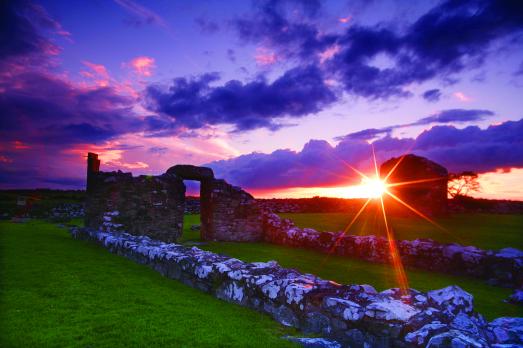
Nendrum Monastic Site
The best example in Northern Ireland of a pre Norman monastic enclosure, sitting on a tidal island.
Newtownwards Priory
Newtownards Priory was a medieval Dominican priory founded by the Savage family around 1244.
Portaferry Presbyterian Church
Portaferry Presbyterian Church was built in 1841, in the Greek revival style, possibly using the Temple of Nemesis on the Greek Island of Rhamnous as a model.
Seagoe Parish Church
On one of the oldest recorded sites of Christianity in Ireland, links to the area date back to the early 500 AD’s.
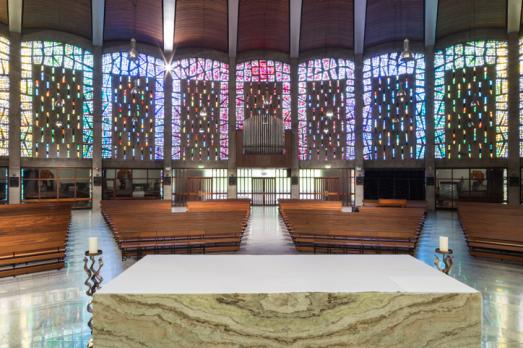
St Bernadette, Belfast
Striking fan shaped 1960s church with Elizabeth Frink's largest Christ sculpture and stunning windows by Dom Charles Norris.
Let’s stay in touch.
We’d like to keep you up to date with our exciting events and new developments. Choose what kind of news you’d like to receive from us.
BBC Broadcasting House

- See all photos
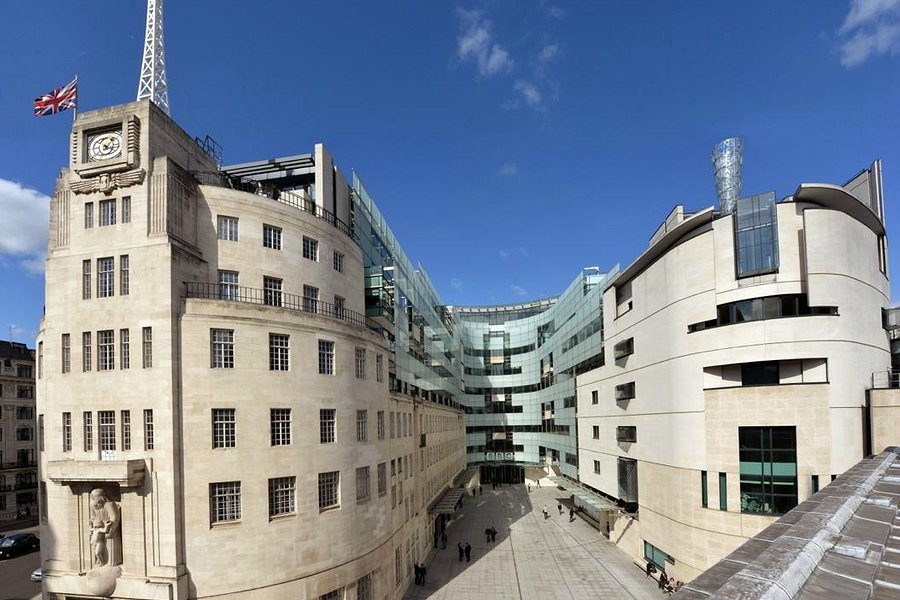
Similar Experiences

Most Recent: Reviews ordered by most recent publish date in descending order.
Detailed Reviews: Reviews ordered by recency and descriptiveness of user-identified themes such as wait time, length of visit, general tips, and location information.
BBC Broadcasting House - All You Need to Know BEFORE You Go (2024)
British Church Architecture Through the Years
British Churches Through the Years “How old is this church?” asks Mary-Ann Ochota in a chapter of her book, Hidden Histories: A Spotter’s Guide to the British Landscape (Francis Lincoln, 2016, p. 250). In this article, we…
28 Jun 19 · 10 mins read

British Churches Through the Years
“How old is this church?” asks Mary-Ann Ochota in a chapter of her book, Hidden Histories: A Spotter’s Guide to the British Landscape (Francis Lincoln, 2016, p. 250). In this article, we will look at British churches and their architecture and how it evolved during the era of Anglo-Saxons and the profound changes during and after the Norman Conquest. Knowing this history will help you spot era-specific features in churches and make an informed guess regarding a church’s age–short of asking a resident historian or architectural expert. We will also look at features of graveyards, which can be found next to churches. Ochota’s book will be a reference, as well as other resources which will be cited and linked throughout this piece.
Pre-Norman Period: Romans, Celts, Anglo-Saxons
When we study churches in Britain, we also study Christianity and its long history. In the 1st century AD, Christianity “was just one cult amongst many” ( BBC, 2011 ) brought to Britain from polytheistic Rome, except that this new religion from the east required exclusive allegiance to one god. Its followers refused to sacrifice to Roman gods, and to the emperor. According to Dr Sophie Lunn-Rockliffe , “This was an insult to the gods and potentially endangered the empire which they deigned to protect. Furthermore, the Christian refusal to offer sacrifices to the emperor, a semi-divine monarch, had the whiff of both sacrilege and treason about it.”
This led to the persecution of its followers. Dr Lunn-Rockliffe said the persecution were sparked by turmoil as Romans looked for someone to blame for their troubles. Nero blamed Christians for the Great Fire of Rome in 64 AD and, according to historian Tacitus, had a number of them torn to death by dogs. Christian persecution was at a fever pitch during the reign of Diocletian in the 3rd century AD, which also coincided with a chaotic political crisis within the Roman Empire. (You can read more about the Roman Empire in our previous article here .) Christians were beheaded, fed to wild animals, or burned to death .
This changed with the conversion of Constantine to Christianity in 312 AD. The new Christian emperor (who, says Dr Lunn-Rockliffe, still included pagan customs in his religious practice) announced in the 313 Edict of Milan his–and the Roman Empire’s–acceptance of Christianity and the decriminalisation of the religion. In 380, the Edict of Theodosius announced that the Empire now recognised Christianity as the state religion.
Thus ended the persecution of Christians in the Roman Empire, but Christianity remained a minority faith in Britain in the 4th century. The Romans left in 410 AD and were replaced by new invaders, the Anglo-Saxons, who brought their own faith. The Germanic Anglo-Saxon pantheon shares similarities with the Scandinavian Viking pantheon, featuring gods like Woden (Odin, god of wisdom) and Thunor (Thor, god of thunder) .
Britain was then cut off from Christian continental Europe. However, Christian missionary activity continued primarily in places where Anglo-Saxons did not settle, like Wales, Ireland, and Western Scotland. St Columba came from Ireland and established a monastic community on the Isle of Iona in 563 (Ochota, 2016, p. 252) and stamped a Celtic identity on Christianity by way of its austere church architecture. Early Celtic churches were usually just one long, narrow room with high walls (p. 252), as simple as the monastic lifestyle.
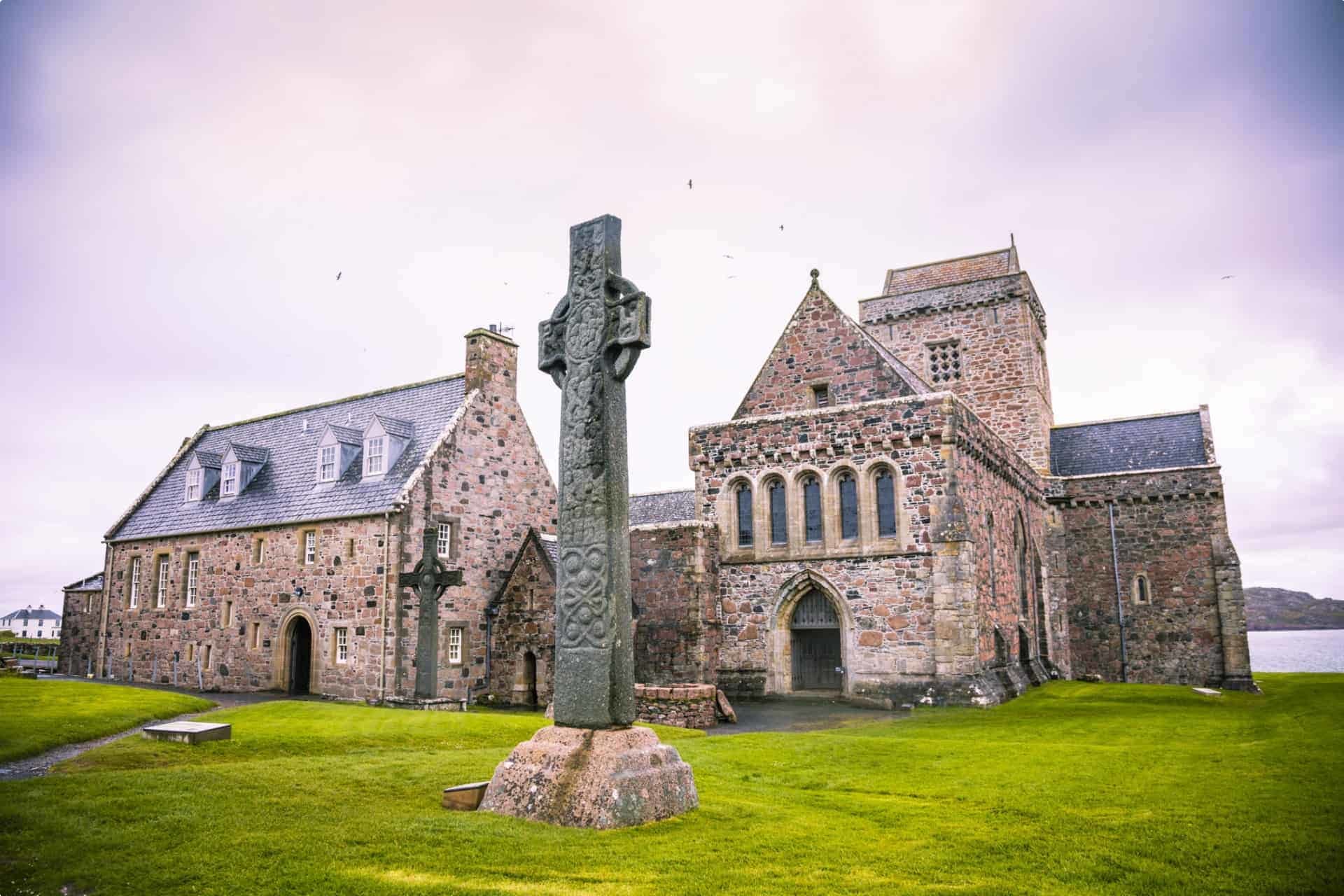
Things were a little different in the south of England. St Augustine came from Rome and arrived in Kent in 595 AD with a mission to convert the Anglo-Saxon pagans. He later founded a church in Canterbury. The churches that were eventually built in southern England took the Roman basilica as inspiration and were bigger and grander (p. 252) than their Celtic counterparts.
The word “basilica” now denotes a title of honour to church buildings, but in ancient Rome it was used to describe any large roofed public building: market, meeting halls, courthouses, etc. Later, it came to denote a specific form of this building, an open hall with side aisles and a raised platform at one or both ends. In pre-Christian Roman architecture, the basilica also featured an apse , or a semicircular recess in a wall, to contain the raised platform. In a temple it would hold the statue of a deity; in a judicial building it would contain the magistrate . This form was adopted by early Christians for their place of worship.
The “basilica” took over northern England as well following the Synod of Whitby , where the Anglo-Saxon kingdom of Northumbria decided to follow Christianity as practised in Rome instead of the way it was practised by the Celtic missionaries on Iona. (For one, the two “Christianities” had different methods for determining Easter.)
The agrarian Anglo-Saxons did not have a stone building tradition, and so their churches were originally built from timber. This unfortunately meant most of these early wooden structures did not survive time and the elements. The remaining Anglo-Saxon timber church still standing is St Andrew’s Church in Greensted, Essex, with planks dating back to 1060 but with some older excavated structures found dating from the 6th and 7th centuries. It is still used for regular Sunday services .
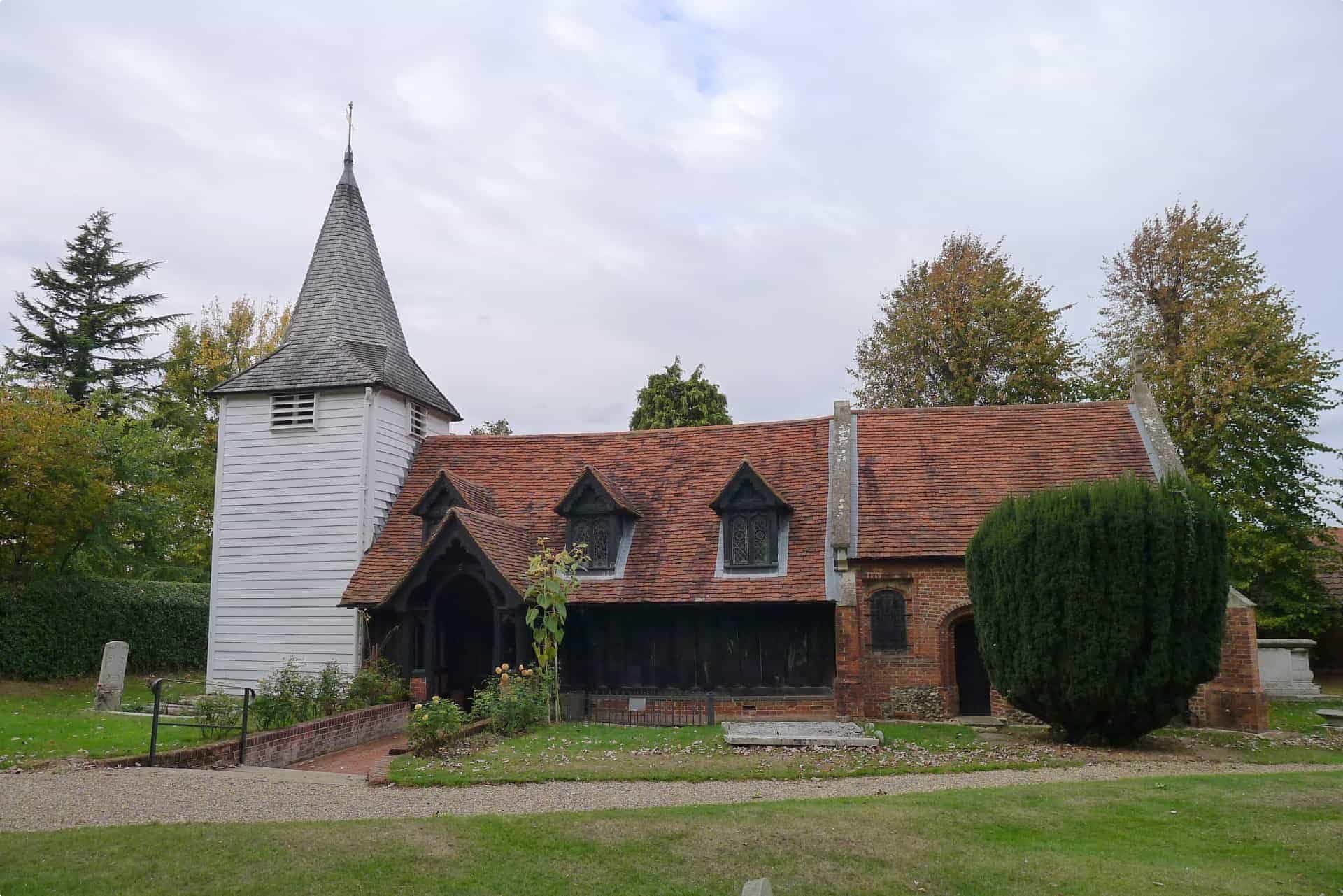
When the Anglo-Saxons started building using stone, they simply reused the bricks left behind by the Romans. One of the earliest stone churches built in England was St Augustine’s Abbey in Canterbury (597 AD) and was constructed in this manner. The largest stone Anglo-Saxon church in Britain is All Saints Church in Brixworth, Northamptonshire (circa 9th century).

Several Anglo-Saxon churches were built as towers (turriform churches), combining “ ecclesiastical, residential, and defensive functions “.
Since Anglo-Saxons were not stone masons and in fact just reusing old materials, the cruder the masonry, the more likely it was the work of Anglo-Saxons (Ochota, 2016, p. 255). Their windows were usually triangular-headed with no glass and separated by a round pillar (baluster). Oddly enough, unlike their windows, Anglo-Saxons used round arches, which were not strong enough for load-bearing. You’d see additional structures (such as voussoirs, or arch stones) added through the years in order to strengthen the arch. You can see this in the south door of Brixworth Church, with the original Anglo-Saxon arch reinforced by a bigger, thicker Norman arch.
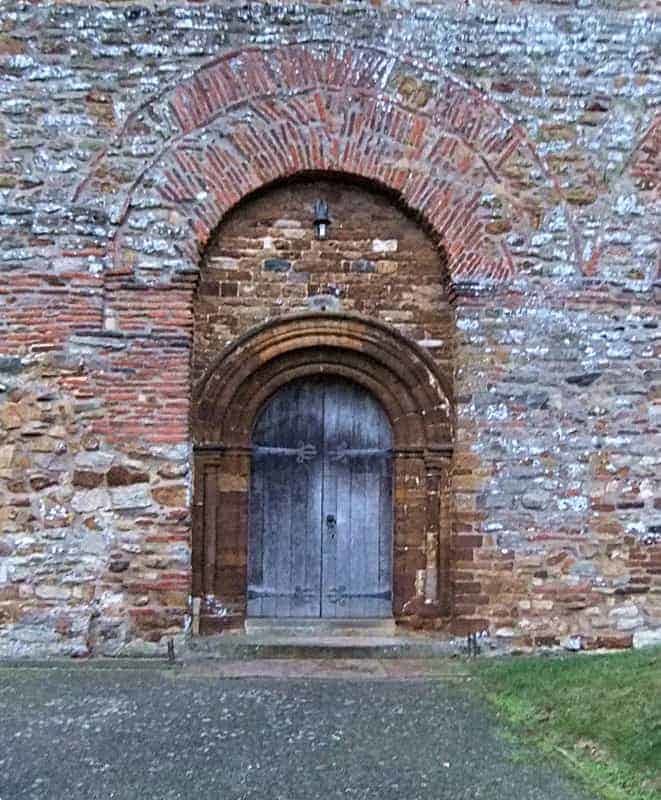
Norman or “Romanesque” Architecture
The Normans’ victory against the Anglo-Saxons at the Battle of Hastings greatly changed life in Britain, primarily in England and much of Wales. For one, William the Conqueror claimed the land for himself and redistributed parcels to his own followers. (You can read more about it here .) They believed God was on their side , and built a church–called Battle Abbey –on their site of victory. The church was dedicated to the Trinity, the Virgin, and St Martin of Tours, and also served as a memorial to those who died in battle and as the Normans’ atonement for the bloodshed.
Their style of architecture was also called “Romanesque” as they derived inspiration from the Romans. Romanesque architecture developed simultaneously in the Normans’ native Normandy (now part of modern-day France) and England in the 11th to 12th centuries, with early buildings in both countries looking similar.
The Normans worked in stone and started building castles and replacing the Anglo-Saxon wooden churches with stone churches. They continued the Anglo-Saxon tradition of round arches and turriform churches, but as skilled masons, Norman walls were thicker , the nave (the room were the congregation gathered) wider, and the round arches stronger and decorated with patterns carved into the stone. They erected enormous load-bearing pillars within the churches and added carved stone fonts to hold water for baptisms. They added corbel tables below the eaves for extra support. Corbel tables are a continuous row of corbels, which are decorative architectural structures that projected from a wall and supported weight .
What is said to be a definitive example of the early Norman style is the Church of Saint-Étienne in Caen, Normandy (also known as Abbaye aux Hommes or “Men’s Abbey”), founded by William the Conqueror. Construction began around 1066-67. The English cathedrals of Ely (circa 1090), Norwich (circa 1096), and Peterborough (circa 1118) were modelled on this church.
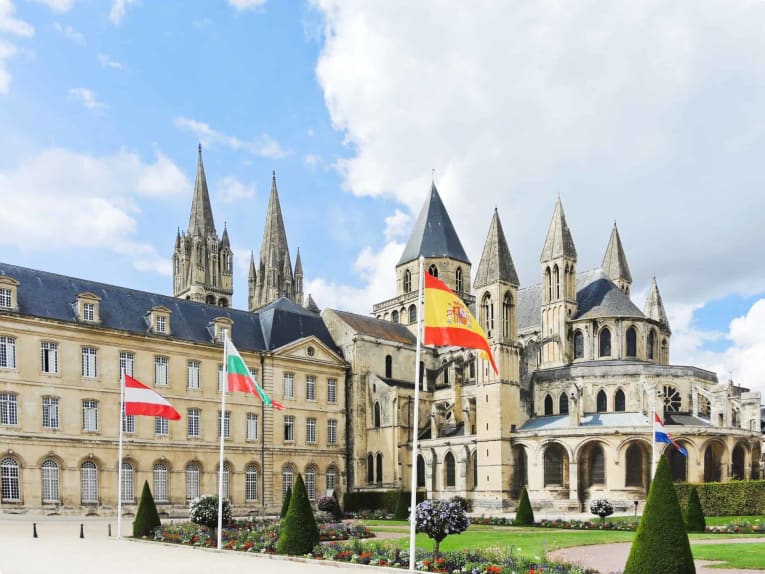
Gothic Period
Around 1140 , a new style of architecture emerged in northern France, initially called Opus Francigenum or “French Work” or “The French Style”, and which in the 16th century was derisively described by art critics as “Gothic”, referring to the “barbaric” Goths who they said destroyed the classical (and more tasteful) architecture of ancient Rome. It was this term of derision that we continue to use to this day, but stripped of the insult.
A main characteristic of Gothic design is the pointed arch, a design change from the rounded arch favoured by the Anglo-Saxons and the Normans. This shape is seen in Gothic windows and ceilings. The years 1160 to 1200 is also called the Transitional period, during which churches were built with a mix of the rounded Norman arch and the Gothic pointed arch (Ochota, 2016, p. 260). Durham Cathedral , constructed beginning 1093, features what is believed to be the world’s first structural pointed arch in its nave.
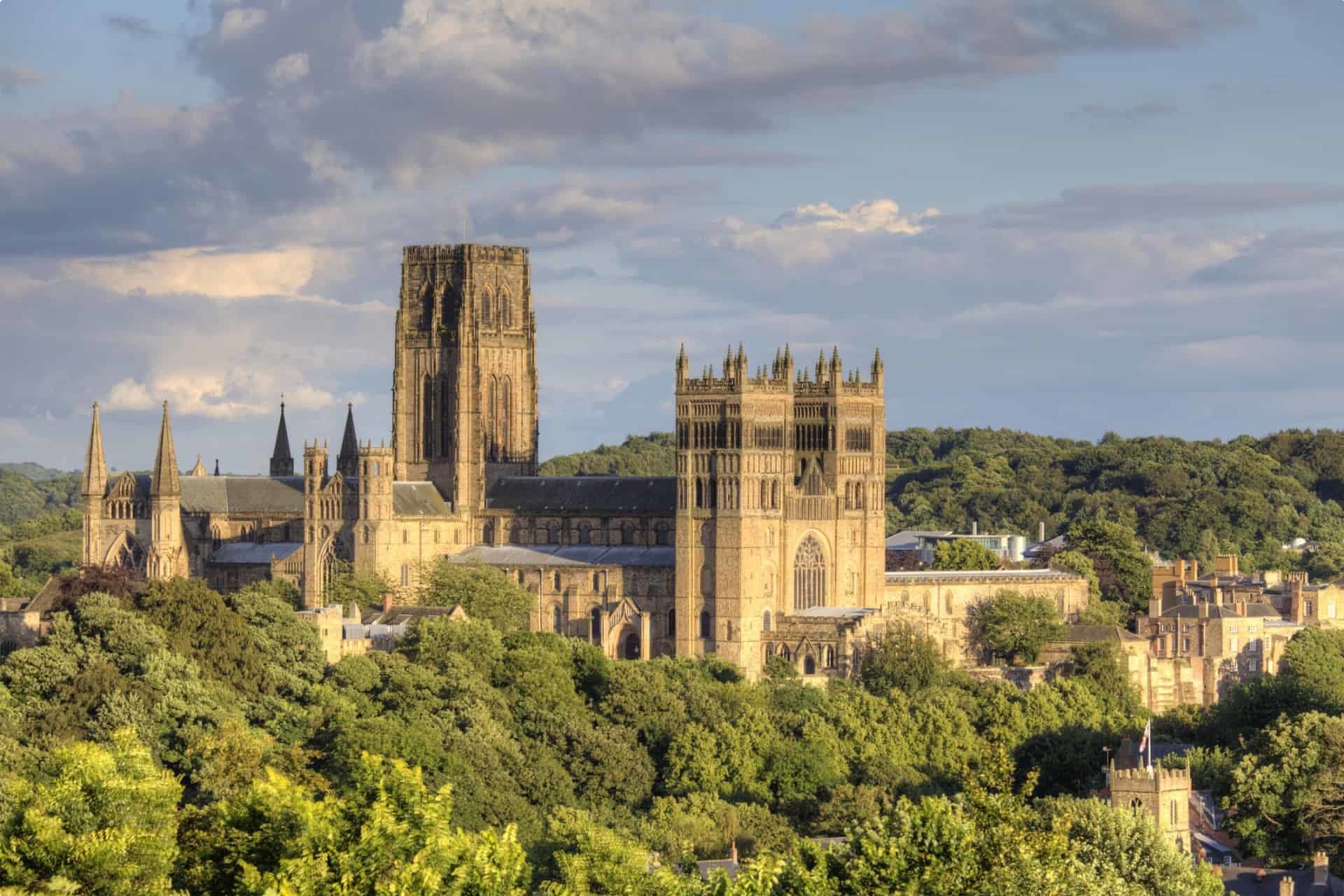
Church design in Britain increasingly became ornate as time passed and as the British adopted more of the elaborate style evolving in Europe. Thomas Rickman in his early 19th century book An Attempt to Discriminate the Styles of English Architecture (1817) divided medieval church architecture in England into three phases of Gothic (Ochota, 2016, p. 260):
- Early English Gothic (1200-1300)
- Decorated Gothic (1300-1400)
- Perpendicular Gothic (1400-1500 in London, but lasting into the 1600s in other parts of Britain)
To tell the difference between phases, you can look at the windows and buttresses (p. 263). Early English windows are also called “lancet” because they look like a lance, narrow and sharply pointed. Decorated Gothic windows are wider , less pointed, with, as the name suggests, decorative tracery. Also as the name suggests, Perpendicular Gothic windows have vertical tracery and framing, cutting the window into uniform panes.
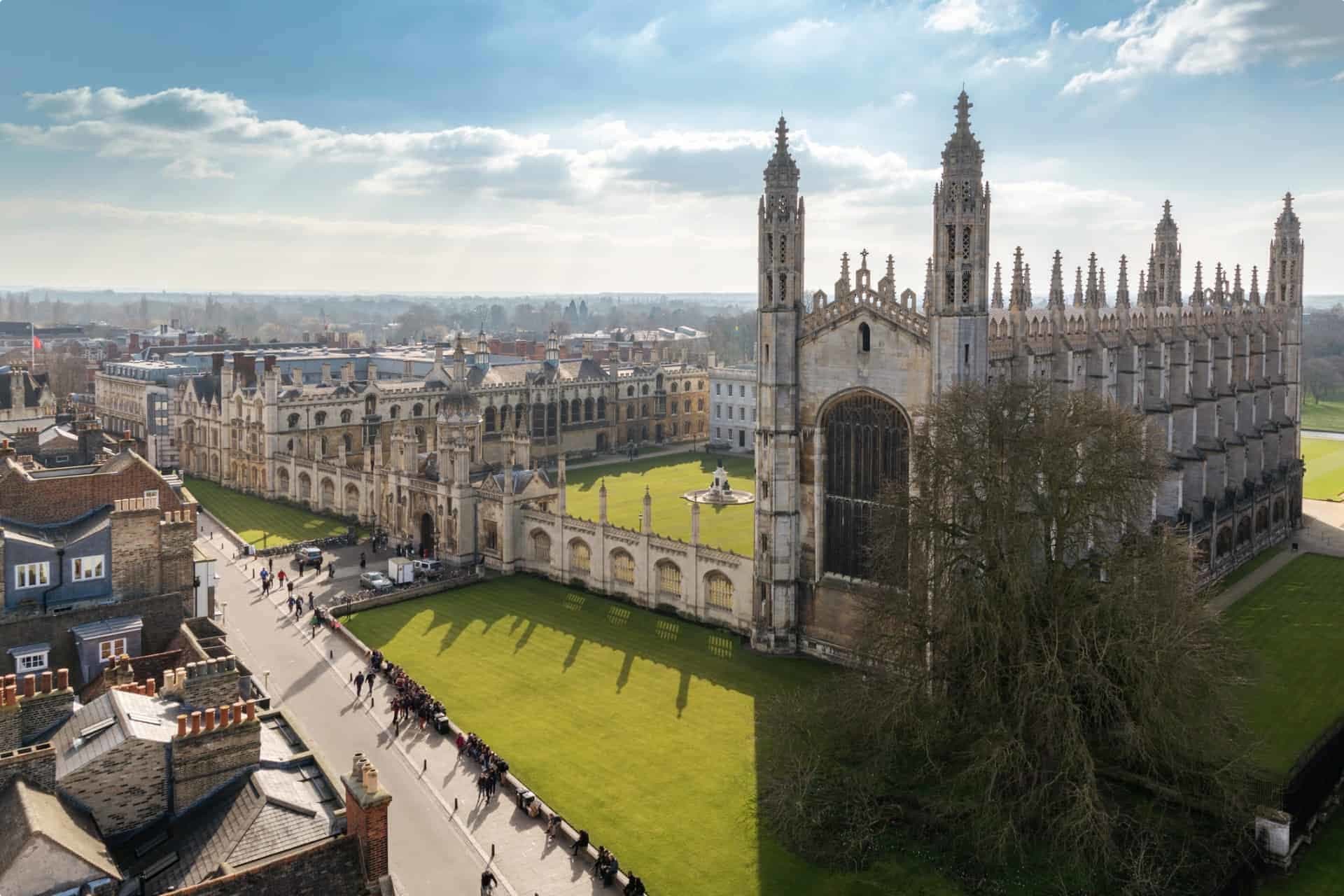
A notable church built in the Perpendicular style was St Mary’s Church in Fairford, Gloucestershire, England. It was rebuilt at the end of the 15th century by John Tame, a wealthy local wool merchant, and according to Robert Winder in his book The Last Wolf: The Hidden Springs of Englishness (Abacus, 2018) has “the largest expanse of medieval stained glass in the country…the nearest thing in England to the Sistine Chapel” (p. 169). Fairford in the 16th century was home to a community of Flemish craftsmen, and St Mary’s stained glass was the work of a Flemish glazier, Barnard Flower (p. 170).
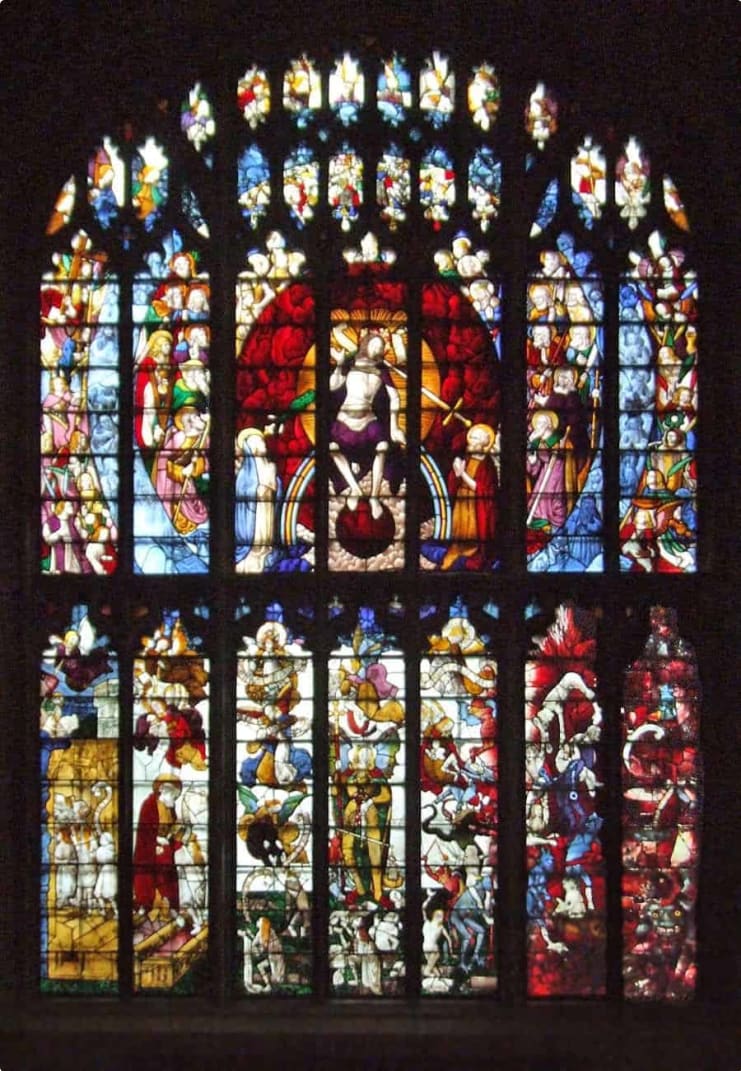
Norman buttresses, or structures of stone or brick built against a wall to strengthen or support it, were thick and shallow, but through the years they became slimmer and projected further from the walls, until churches sported “flying buttresses” starting around the 1400s.
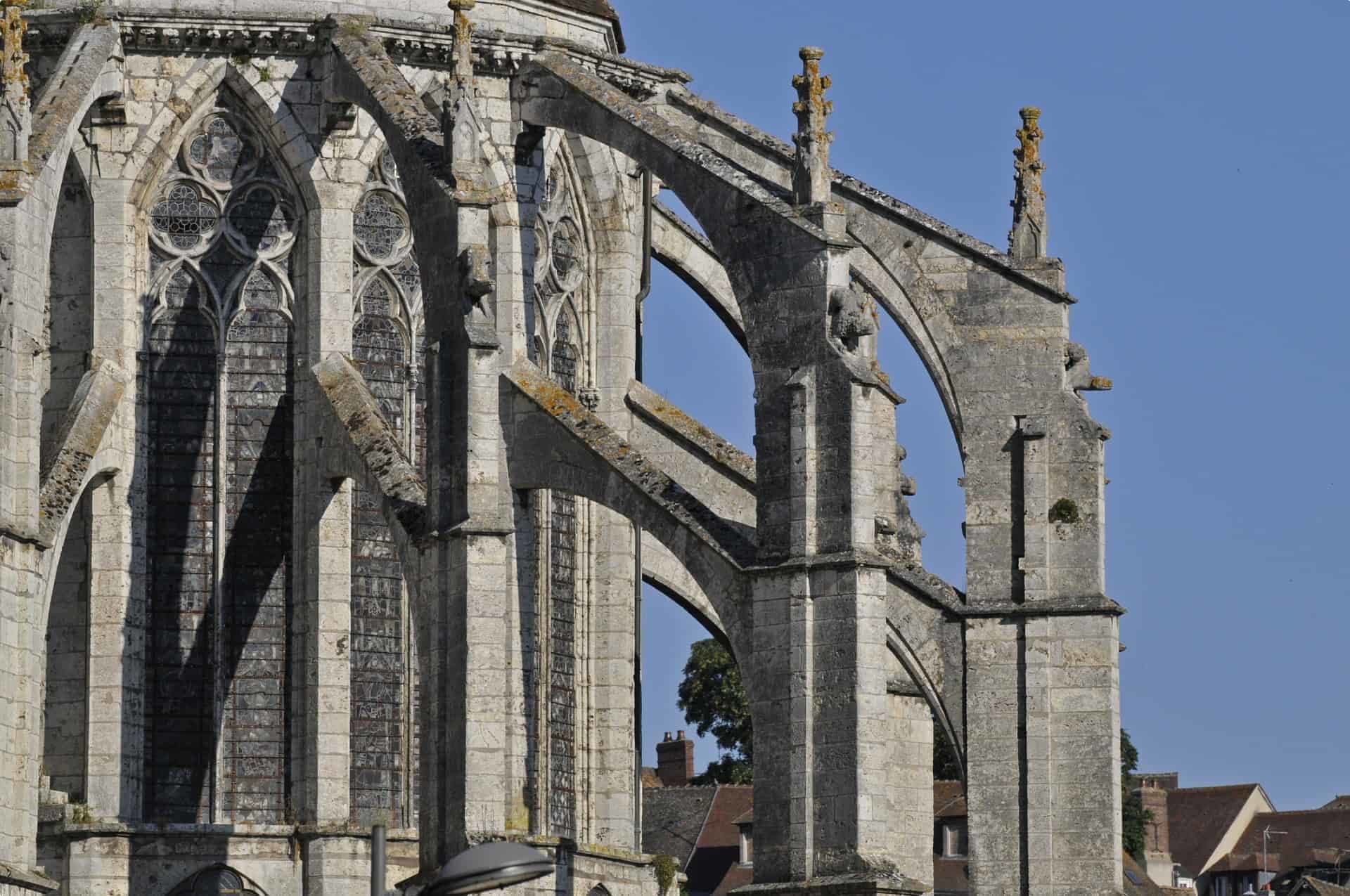
These and other structural elements (spires, vaulted ceilings) allowed the British to build taller churches with thinner walls that were still structurally sound, and larger windows that would allow in more natural light. (Early Norman churches, with their smaller windows, would have been quite dark in comparison.)
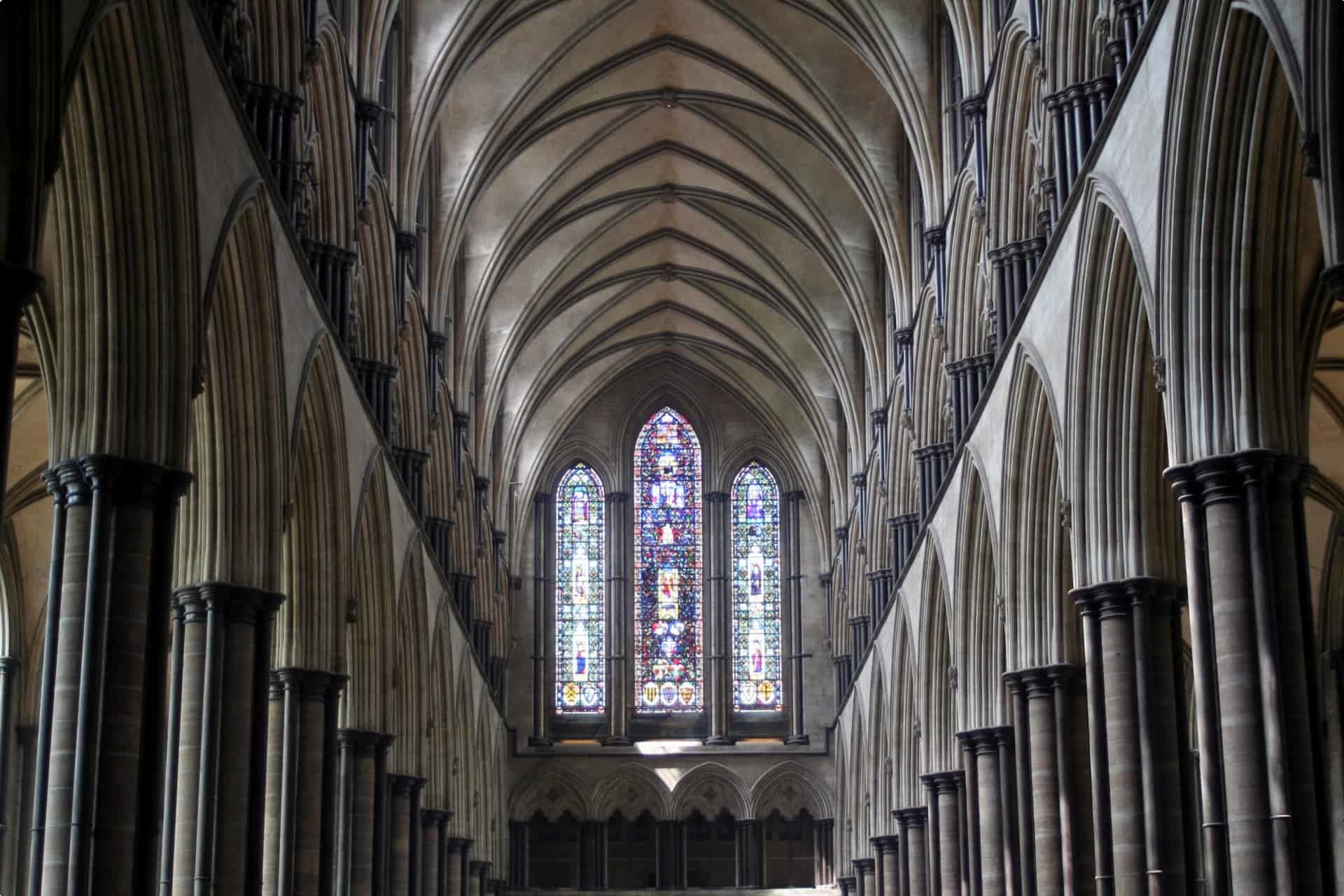
The Gothic style made a comeback in the 19th century, the style called neo-Gothic or Victorian Gothic, using the more elaborate Perpendicular style or, as the Victoria & Albert Museum says, exaggerations of the Gothic’s key architectural elements.
In the introduction to his book, At Home: A Short History of Private Life (Doubleday, 2010), Bill Bryson mentions a friend, retired county archaeologist Brian Ayers, who tells him how country churches appear to be sinking–but only because the churchyard has risen from all the bodies buried there. As Ochota (2016, p. 270) confirms, “centuries of interments progressively raise the earth surface”. So the higher the graveyard, the older it is.
In Roman times, there were strict rules against having the necropolis (“city of the dead”) within the boundaries of a settlement throughout the empire, according to the United Kingdom’s Natural History Museum. This meant they had to be set up outside the city limits. Bodies were either cremated and the ashes interned in an urn, or buried with possessions that could help them in the afterlife.
The oldest example of an Anglo-Saxon Christian burial was unearthed in 2003 during roadworks in Prittlewell, near Southend, Essex. Found between a pub and an Aldi supermarket, the timber structure also housed rare and precious artefacts such as gold coins and gold-decorated drinking vessels, leading researchers to believe the burial must have belonged to an Anglo-Saxon prince. Gold-foil crosses were found at the head of the coffin, which means, according to the Museum of London Archeology , “the person buried can be identified with certainty as a Christian but he was also buried with funerary customs that reflect pre-Christian beliefs and traditions, including the burial mound, the chamber and the grave goods.” MOLA provides more information on their website about the excavation . In 2019, the chamber items were moved to the Southend Central Museum to be placed on permanent display.
In the Christian tradition, the bodies of the faithful had to be buried in the hallowed ground of the churchyard. This posed overcrowding problems during the Middle Ages, which led parishes to build charnel houses, or a vault to store human skeletons. As space is at a premium, bones would be exhumed from a grave and placed in the charnel house (that might be in or near the church) and the now-empty grave reused for the next burial.
Yew trees are found in Christian churchyards, but they have been planted since pre-Christian times. The yew was considered by native Britons to be a sacred tree and co-opted by Christians as a symbol of eternal life (Ochota, 2016, p. 272).
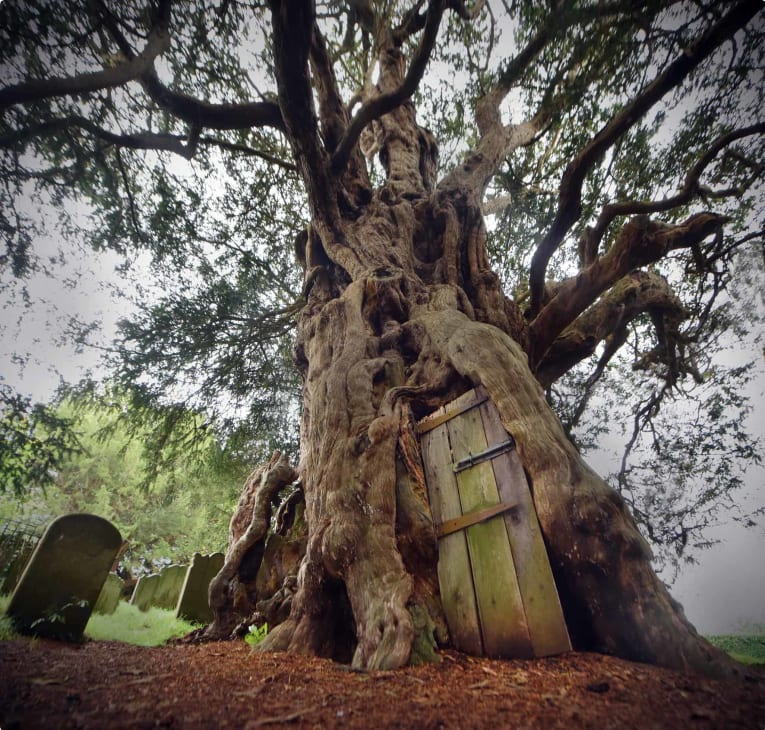
According to the National Churches Trust , graves in the churchyard face east–with the head to the west and the feet to the east–so the resurrected will face Jesus, who will be approaching from the east at the final Day of Judgement. Most burials traditionally took place on the south side of the church; the north side was seen as sinister (Ochota, 2016, p. 273) and used to bury unbaptised infants, criminals, or suicides. Priests, royals, and other people of equal standing were buried within the church; everyone else was buried outside in the churchyard.
Some English graveyards have lych-gates (from Old English lich=corpse) though most that survive date from Victorian times as medieval lych-gates were made of timber and had long since fallen. Lych-gates were where the corpse was brought and the priest approached to receive it for initial prayers, before moving on to the churchyard for the burial.
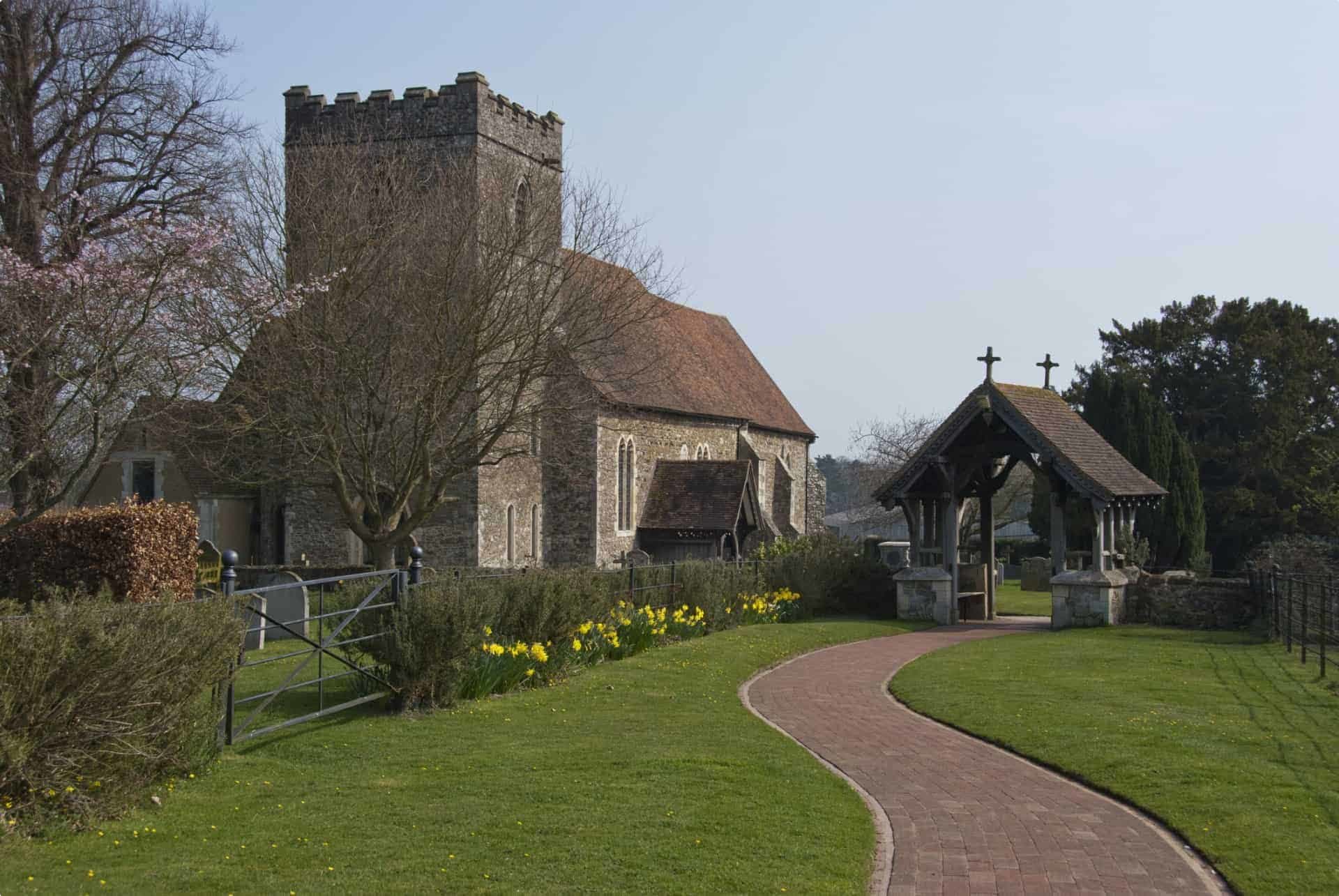
If you want to learn more, please read Mary-Ann Ochota’s Hidden Histories: A Spotter’s Guide to the British Landscape (Francis Lincoln, 2016), Bill Bryson’s At Home: A Short History of Private Life (Doubleday, 2010), and Robert Winder’s The Last Wolf: The Hidden Springs of Englishness (Abacus, 2018), as well as the many online resources linked throughout this piece.
You may also consider joining one of Odyssey Traveller’s many tours to the British Isles, such as the Villages of England tour, a 19-day fully escorted tour that will let you explore the history and culture of the British countryside; the Prehistoric Britain tour, which visits Skara Brae and other historic sites in Orkney, Shetland, and Wales; and the tour of the Scottish Isles which includes a stop in Iona. We specialise in small groups for senior travellers. Just click through to see each tour’s full itinerary and sign up!
For more information on all of our tours to the British Isles, click here .
Related Tours
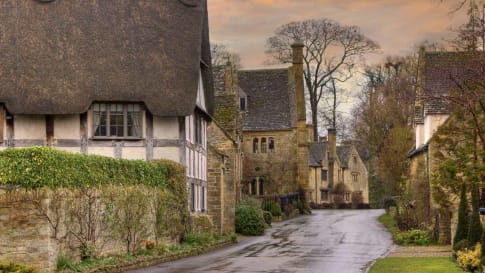
England’s villages small group history tours for mature travellers
Visiting England
Guided tour of the villages of England. The tour leader manages local guides to share their knowledge to give an authentic experience across England . This trip includes the UNESCO World heritage site of Avebury as well as villages in Cornwall, Devon, Dartmoor the border of Wales and the Cotswolds.
From A$16,995 AUD
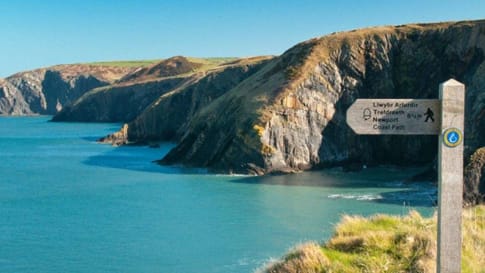
Exploring Wales on foot : small group walking tours for seniors
Visiting Wales
A Walking tour of Wales with spectacular views across as you walk the millennial path across the Irish sea or up in Snowdonia national park . This guided tour that provides insight into the history of each castle visited and breathtaking scenery enjoyed before exploring the capital of Wales, Cardiff with day tours of Wales from Cardiff. For seniors, couples or Solo interested in small groups.
From A$11,340 AUD
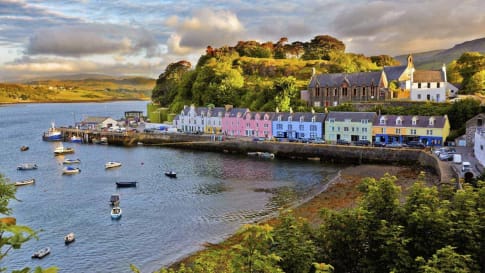
Scottish Islands and Shetland small group tours for seniors
Visiting Scotland
An escorted small group tour for couples and solo travellers of the Scottish isles including the isle of Skye draws on local guides to share their knowledge of the destinations in this unique part of Scotland . UNESCO world heritage site are visited as breathtaking scenery and authentic experiences are shared in a group of like minded people on this guided tour of remote Scotland.
From A$16,695 AUD
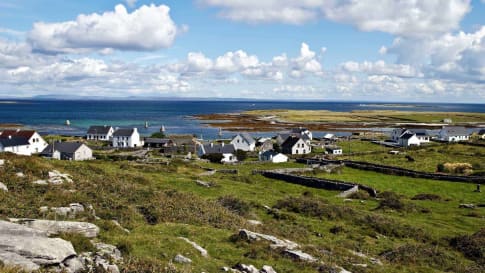
Small Group tours exploring the Treasures of Ireland
Visiting Ireland
An escorted small group tour to Northern Ireland & Ireland , with local guides and itineraries that give authentic experiences Ireland 's capital, Dublin , including 1/2 day tour of St Patricks cathedral and Trinity college. Destinations also Aran islands , Kerry plus the world heritage site, the giant's causeway. Ireland tours for singles over 50 and couples.
From A$12,615 AUD
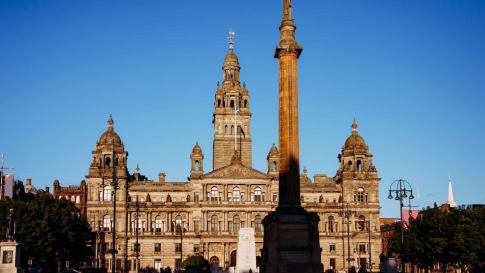
Liverpool, Newcastle, Glasgow
Visiting England, Scotland
Spend 22 days in 3 cities in England and Scotland . Your tour leader and Knowledgeable local guides examine the history of these great cities. Liverpool & Glasgow faced onto the Irish sea, and Newcastle onto the North sea, and all where connected to the city of London .
From A$13,915 AUD
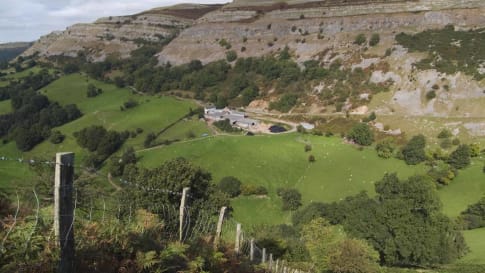
Walking Ancient Britain
A walking tour of England & the border of Wales . Explore on foot UNESCO World Heritage sites, Neolithic , Bronze age and Roman landscapes and the occasional Norman castle on your journey. Your tour director and tour guide walk you through the Brecon beacons , the Cotswolds and Welsh borders on this small group tour.
From A$13,995 AUD
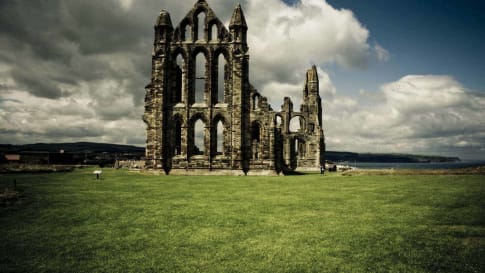
Rural Britain | Walking Small Group Tour
A walking tour into England , Scotland and Wales provides small group journeys with breathtaking scenery to destinations such as Snowdonia national park , the UNESCO world heritage site Hadrians wall and the lake district . each day tour provides authentic experiences often off the beaten path from our local guides.
From A$15,880 AUD
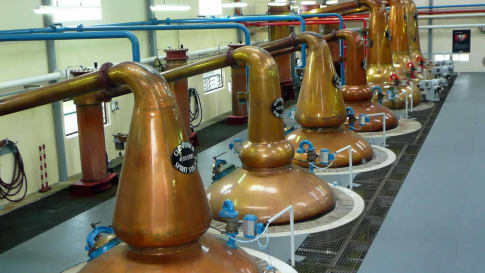
Whisky and Other Scottish Wonders
A guided small group tour of Scotland is a day tour collection that includes Edinburgh , the royal mile, Edinburgh castle, and the old town a UNESCO World heritage site Experience and learn about, Kellie castle, St Andrews, Skye, Balmoral castle, Loch Lomond and Loch Ness as well touring the Scottish highlands to finish in Glasgow .
From A$17,525 AUD
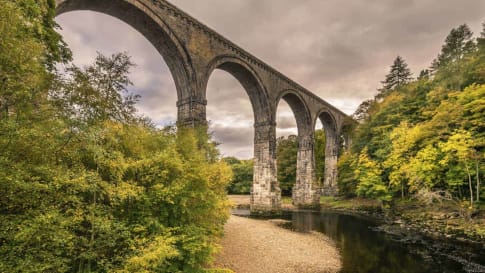
Canals and Railways in the Industrial Revolution Tour | Tours for Seniors in Britain
A small group tour of Wales , Scotland & England that traces the history of the journey that is the Industrial revolution . Knowledgeable local guides and your tour leader share their history with you on this escorted tour including Glasgow , London , New Lanark & Manchester , Liverpool and the Lake district .
From A$17,860 AUD
Architecture

British Isles

Channel Islands

Join 22,383 like-minded travellers receiving our weekly newsletter.

We are delighted to share with you our library of resources. You can use the filter feature below to find topics most relevant to your curriculum.
Different Features of a Church
A tour of a church.
In this series of films Andi and Jack are shown around the church by Rev Liz and discover the answer to many questions such as:
- What is a font?
- Why are candles used in church?
- What is a pulpit?
- What happens at the altar, and why do Christians celebrate Holy Communion?
- What do Christians believe happens when we die?
- What does a vicar wear and what are the Church colours?
Each short film explores a different aspect of the church building.
Otley Parish Church
A Place For Everyone, Christ At The Centre
Clear Here to see the superb imaging of the church done by Apollo 3D. It’s linked to our historical tour of the church.

- International edition
- Australia edition
- Europe edition

‘The working class can’t afford it’: the shocking truth about the money bands make on tour
As Taylor Swift tops $1bn in tour revenue, musicians playing smaller venues are facing pitiful fees and frequent losses. Should the state step in to save our live music scene?
W hen you see a band playing to thousands of fans in a sun-drenched festival field, signing a record deal with a major label or playing endlessly from the airwaves, it’s easy to conjure an image of success that comes with some serious cash to boot – particularly when Taylor Swift has broken $1bn in revenue for her current Eras tour. But looks can be deceiving. “I don’t blame the public for seeing a band playing to 2,000 people and thinking they’re minted,” says artist manager Dan Potts. “But the reality is quite different.”
Post-Covid there has been significant focus on grassroots music venues as they struggle to stay open. There’s been less focus on the actual ability of artists to tour these venues. David Martin, chief executive officer of the Featured Artists Coalition (FAC), says we’re in a “cost-of-touring crisis”. Pretty much every cost attached to touring – van hire, crew, travel, accommodation, food and drink – has gone up, while fees and audiences often have not. “[Playing] live is becoming financially unsustainable for many artists,” he says. “Artists are seeing [playing] live as a loss leader now. That’s if they can even afford to make it work in the first place.”
Potts, who works at Red Light Management – home to everyone from Sabrina Carpenter to Kaiser Chiefs and Sofia Kourtesis – feels like there is an industry equivalent of the Spider-Man meme in which they are all pointing to one another. “People who work at labels think bands make loads of money touring, while booking agents think they make loads of money on publishing and so on,” he says. “Everyone thinks artists make money from the other side of the industry they’re not involved in.
“Artists are the biggest employers in the industry. They pay for the tour manager, session musicians, agent, manager, crew, insurance, travel, accommodation, equipment, rehearsal space, production. Everything. I don’t think people know this is all the stuff that the artist pays for and does.”

“Greater transparency is needed,” says Lily Fontaine, lead singer of Leeds band English Teacher. On paper, the four-piece appear to have made it. They are signed with a major label, Island, have played on Later With … Jools Holland, get healthy BBC Radio 6Music airplay, their debut album has received five-star reviews and they are about to embark on their biggest tour to date, which includes an 800-capacity home-town show.
“The reality is that it’s normal for all of these achievements to coexist alongside being on Universal Credit, living at home or sofa surfing,” says Fontaine. During the making of their debut album, she and bandmate Lewis Whiting did the latter while unable to afford rent.
In their four years of existence, English Teacher have yet to turn a profit from touring. “We’ve never directly paid ourselves from a gig,” says Whiting. “A headline tour usually comes out with a deficit. The only thing that we ever make any kind of profit on is festivals, because the fees can be higher, but any money left over just goes towards the next outgoings.” A successful show for the group in the past has been defined by whether they can flog enough merch to afford a supermarket food shop.
So how do they survive? “In the world of artists, we’re in a lucky position,” says Whiting. “We try to pay ourselves £500 a month each from the band pot.” However, they’ve been reliant on their advance for this, which is now gone. “We’re now in that stage where we’re gonna have to figure out where that £500 a month is gonna come from,” says Fontaine. “Because the gig fees won’t be able to cover that.” The band estimate that their 16-date UK tour in May will generate roughly £800 profit. But, says Fontaine, “realistically, I don’t think there will be any profit because things always go over budget”.
For many artists, fees aren’t increasing in line with costs. “There’s been no real incline at all,” says Potts. “For support slots, I don’t think the fees have changed in the last 10 years or so that I’ve been managing, whether that’s £50 at the smaller end or £500 quid for some of the biggest shows.” Fees for headline shows can vary enormously for bands, even on the same tour. Playing a 200-capacity club in Newcastle may land you £600, while a 1,500 cap in London may net you £3,000.
And fewer people are coming to shows at the small-to-mid-sized end of things. “In our audience data, we see there is a gap in new audiences coming through post-pandemic,” says the FAC’s Martin. “As well as a bit of a drop-off in some of the older audiences returning to live shows.” However, despite stagnant fees and shrinking audiences, touring activity in the UK is at a peak. Due to the costs of touring Europe (which can be thousands in taxes and carnet alone) 74% fewer UK bands are now touring Europe post-Brexit. “It’s much more difficult to tour in Europe so there are more artists trying to perform domestically,” says Martin. “That creates a saturation problem.”
For this article, the Guardian has seen 12 tour budget sheets for various bands and artists varying from up-and-comers to firmly established and successful acts, all of whom regularly undertake headline tours across the UK in venues ranging from 150 to 2,500 capacity. Almost all of these result in losses. Understandably, most shared their balance sheets on the condition of anonymity. One four-piece indie band, whose last two albums went Top 10 in the UK charts, reported a loss of £2,885 from a six-day UK tour. The only tour that shows anything resembling healthy profit was a 29-date tour for a solo artist who came away with £6,550. Not bad going for a month’s work but, as Martin points out, “that’s then his touring done for the next six months. So it’s not enough money.”

Nubiyan Twist are a nine-piece Afro-jazz outfit who have a loyal following and tens of millions of streams on Spotify, “We pride ourselves on being able to put on a big show, like your Fela Kutis or James Browns, these epic spectacles,” says bandleader Tom Excell. “But it’s getting more difficult, without a shadow of a doubt.” For an upcoming eight-show tour of Europe, they are predicting a loss of £4,931.28. The only way they can justify doing it is because they got funding from the BPI Music Export Growth Scheme. “I would have just pulled the plug if it wasn’t for that,” says Excell. “I’ve got a two-year-old and I can’t be away from home for that long and come back with a loss.”
Even when the band get more lucrative fees for festivals it’s still tough. They will be paid £5,000 for a festival performance this summer but the total profit after band wages (as Excell pays all his band members in full first) expenses and commissions are paid out will be £277.60. “After four albums and 15 years doing this, to still be having to gamble on whether I’m going to make anything, while everyone else gets paid a guaranteed amount, is a struggle,” admits Excell.
Such thin margins leave little wiggle room, as the space-surf band Japanese Television (who headline 100-300 capacity venues) found out when their booking agent reduced their 13-date UK and EU tour to eight shows with a five-day gap in the middle that will add a further loss of around £1,200 to a tour that is already set to lose them around £700. “Records and T-shirts are basically what keeps us going,” says the band’s Tim Jones. “The only way this tour is working for us is because we just put out our second album and we did about 60 presales on the vinyl and that was basically enough to pay for the van. It’s a hobby that just about pays for itself.”
after newsletter promotion
The question is: who else will be able to afford to pursue music as a hobby? “It depresses me how many middle and upper class people there are in the music industry,” says manager Potts. “Because the working class just can’t afford to fork out £150 a day for van hire. The only artists doing that are people who have deeper pockets and can afford to take the hit.”
Of course, every act is different in terms of what they justify as reasonable outgoings and not everyone has the same costs, but Potts says from his experience, generally speaking, bands with four or five members now need to be playing 2,000+ capacity venues nationwide to “really start to see things tip”. That tipping point is out of reach for the majority. “Most people don’t actually get to that level,” Potts says. “Just look back at any festival lineup from 10-20 years ago and see which names are still on festival bills and how many you’re like: what happened to them?”
The gap between those who are flying and those who are floundering has become even more stark. “It feels like the top 1% have become the top 0.5%,” says Martin. “The level of artists we’re talking about here that are struggling to make things stack up financially would really surprise people.”
In 2022, the Grammy-winning Pakistani singer Arooj Aftab posted on X: “Touring has been amazing. We headlined a ton, had massive turnouts and have proven ourselves in all the markets. Yet still, running tens of thousands in debt from the tour and I’m being told that it’s ‘normal’. Why is this normal? This should not be normalised.”
I’m told that one US artist – who released one of the most critically acclaimed albums of 2023, which went Top 10 and placed very highly on numerous year-end polls and was nominated for a major award – worked out that the only way she could make her UK tour work was by sub-letting her home.

It’s a far cry from Taylor Swift’s record-breaking Eras jaunt. “The very high end of the live industry is reporting record profits,” says Martin. “You can’t have a healthy music ecosystem where at one end you’ve got people going ‘we’ve made more money than we’ve ever made’ and at the other end you’ve got relatively successful artists that are sofa-surfing while signed to a major label.”
Is there an answer? “When you’re touring Europe, you realise how much state funding in the arts there is,” says Excell. “It really needs more state funding and support from the top down.”
Martin echoes this. “The government needs to start looking at spending money on the music industry as an investment rather than as a cost,” he says. “But you also need to support a sector in a time of crisis. And this is a time of crisis.”
- Pop and rock
- Music industry
- Taylor Swift
Comments (…)
Most viewed.

CMT On Tour Presents Mickey Guyton: North American Dates Will Stop In 22 Cities

Tickets Available Starting Tuesday, April 30 via Artist Presale
General onsale begins friday, may 3 at 10 am on mickeyguyton.com.
Four-time Grammy®-nominated country performer Mickey Guyton will headline the latest installment of “CMT On Tour ,” produced by Live Nation . “ CMT On Tour Presents Mickey Guyton ” kicks off Sept. 18 at Buckhead Theatre in Atlanta, GA with a 22-city tour across major cities in North America including New York, Chicago, Columbus, St. Louis, Toronto, Washington, D.C. and more, wrapping up in Lexington, KY at Manchester Music Hall on November 9.
The tour announcement also coincides with the release of Mickey’s new single “Scary Love,” which she released today and can be streamed HERE . “Scary Love” showcases Guyton’s undying appreciation for motherhood and serves as a ballad dedicated to her three-year-old son.
Earlier this month, Mickey also shined at the 2024 CMT Music Awards on CBS, where she earned nominations for “Collaborative Video Of The Year” and “Video Of The Year” for her collaboration with Kane Brown on “ Nothing Compares To You. ”
TICKETS: Tickets will be available starting with an artist presale beginning Tuesday, April 30 at 10 AM local time. Additional presales will run throughout the week ahead of the general ticket on-sale beginning Friday, May 3 at 10 AM local time at MickeyGuyton.com .
TOUR DATES:
Wednesday, September 18 | Atlanta, GA | Buckhead Theatre
Friday, September 20 | Charlotte, NC | The Underground
Saturday, September 21 | Asheville, NC | The Orange Peel
Thursday, September 26 | Washington, DC | Union Stage
Friday, September 27 | New York, NY | The Gramercy Theatre
Saturday, September 28 | Pittsburgh, PA | Thunderbird Café and Music Hall
Wednesday, October 2 | Kansas City, MO | Knuckleheads*
Thursday, October 3 | Oklahoma City, OK | Beer City Music Hall*
Tuesday, October 15 | St. Louis, MO | Delmar Hall
Thursday, October 17 | Chicago, IL | Joe’s on Weed St.
Friday, October 18 | Minneapolis, MN | First Ave*
Saturday, October 19 | Des Moines, IA | Wooly’s
Tuesday, October 22 | Madison, WI | Majestic Theatre
Wednesday, October 23 | Ann Arbor, MI | Blind Pig
Friday, October 25 | Grand Rapids, MI | The Stache at The Intersection
Wednesday, October 30 | Columbus, OH | The Bluestone
Friday, November 1 | Buffalo, NY | Iron Works*
Saturday, November 2 | Toronto, ON | Velvet Underground
Monday, November 4 | Boston, MA | Brighton Music Hall
Wednesday, November 6 | Philadelphia, PA | World Cafe Live*
Friday, November 8 | Indianapolis, Indiana | The Hifi*
Saturday, November 9 | Lexington, KY | Manchester Music Hall
*Not a Live Nation Date
About Mickey Guyton
Capitol Nashville’s Mickey Guyton “raises the rafters and distills emotion with impeccable clarity. Her high notes thrill, her nuance in storytelling captivates. A star for our times claims her place” (NPR). The four-time GRAMMY nominee and 2022 TIME Breakthrough Artist of the Year Guyton released songs “I Still Pray,” “How You Love Someone” and “Somethin’ Bout You” following her critically acclaimed 2021 debut album, Remember Her Name . Most recently, she unveiled her latest singles “Scary Love” and “Woman” to maintain her momentum in 2024.
With Remember Her Name , Mickey made history as the first Black artist to earn a GRAMMY nomination for Best Country Album. Title track “Remember Her Name” also landed Mickey with GRAMMY nominations for Best Country Song and Best Country Solo Performance. This follows Mickey’s groundbreaking GRAMMY nomination as the first-ever Black female solo artist to earn a nod in a country category (Best Country Solo Performance) for “Black Like Me” which she performed as part of the 2021 awards ceremony. “Black Like Me” was named one of the Top 10 all-genre songs of 2020 by NPR, Billboard , and Associated Press . She also co-hosted the 56thAcademy of Country Music Awards on CBS along with Keith Urban and she was named CMT’s 2021 Breakout Artist of the Year. Audiences around the world watched Mickey deliver a powerful message of inclusivity and togetherness with her “awe-inspiring,” “soulful and soaring” national anthem at Super Bowl 56 in Los Angeles.
Mickey and her music have been featured on the cover of Billboard and profiled in The New Yorker , The New York Times and Rolling Stone . Over the last year she has been featured in American Songwriter, BBC News, CBS Mornings, Ebony , Elle , Ellen, Entertainment Weekly , Essence , HITS , Sesame Street, SHERRI, The Jennifer Hudson Show, The Kelly Clarkson Show, The Late Show with Stephen Colbert, Los Angeles Times , New York Magazine’s Vulture , PEOPLE , Pollstar , Sesame Street, TODAY Show, The Tonight Show Starring Jimmy Fallon, USA Today , Variety , VIBE , The View, Vogue , The Washington Post and many more.
About Live Nation Entertainment
Live Nation Entertainment (NYSE: LYV) is the world’s leading live entertainment company comprised of global market leaders: Ticketmaster, Live Nation Concerts, and Live Nation Sponsorship. For additional information, visit www.livenationentertainment.com .
About CMT On Tour
Created in 2002 as a platform to support and propel breakout artists toward headliner status, “CMT on Tour” has featured some of the biggest and most well-respected artists in country music today, including Eric Church, Keith Urban, Lady A, Little Big Town, Luke Bryan, Miranda Lambert, Sara Evans, Sugarland, Thomas Rhett and many more.
MEDIA CONTACTS:
Ali Marszalkowski | [email protected]
Mickey Guyton
Leigh Malleus | UMG Nashville | [email protected]
Didier Morais | Vital Versatility | [email protected]
Chantel Muentes | Vital Versatility | [email protected]
Live Nation Concerts
Monique Sowinski | [email protected]
Nadine Peña | [email protected]
Read more about
Man jailed for raping vulnerable woman near church

Mohammed Javeed promised to help the woman before pushing her into bushes and raping her, police said
- Published 25 April 2024
A man who preyed on a stranger and raped her near a church has been jailed for seven years.
Mohammed Javeed from Wellington in Shropshire was sentenced at Shrewsbury Crown Court on Wednesday after being convicted by a jury of the late-night attack.
Describing his victim as vulnerable, police said the 32-year-old targeted her in June 2021, promising to help her.
But instead he pushed her into bushes near All Saints Church in Wellington and raped her.
A member of the public then disturbed Javeed, causing him to run off.
That individual contacted police, who launched an investigation.
The West Mercia force said its detectives went through CCTV footage from the evening, from which they were able to identify Javeed and swiftly arrest him.
Det Con Erica Hanson-McKenzie, who led the investigation, said: "Javeed preyed on a vulnerable woman late at night and I am pleased with the sentence that has been handed to him by the judge.
"Reporting crimes like these can take a lot of courage, and I would like to commend the victim in this case on the immense strength she showed in assisting us with our investigation, and her strength throughout the trial.
"I hope the sentence given to Javeed sends a clear and strong message that we can and do take all reports of rape seriously and will work tirelessly to secure charges against those responsible."
Javeed, who was also convicted of attempted rape in relation to the same woman, has been added to the sex offenders' register indefinitely.
Follow BBC West Midlands on Facebook , external , X , external and Instagram , external . Send your story ideas to: [email protected] , external
Related Topics
Related internet links.
West Mercia Police

IMAGES
COMMENTS
A visit to a church. Part of Religious Education Christianity Year 1 Year 2. Hannah is stood outside her church. A church is a place where Christians come to worship. There are lots of different ...
Monuments of faith. Christianity is thought to have arrived in Britain in the 2nd Century, when most of the country was part of the Roman Empire. Today, there are around 37.6 million Christians in ...
Andi & Jack take a tour around a Church with Rev. Liz, who explains what a font is.For more films like this, visit http://request.org.uk/restart/2015/01/12/t...
Subscribe and 🔔 to the BBC 👉 https://bit.ly/BBCYouTubeSubWatch the BBC first on iPlayer 👉 https://bbc.in/iPlayer-Home Explore the Hagia Sophia. Built by t...
Tour our church and churchyard to find out more about a rich history and connections to the world renowned Ironbridge Gorge. Wales. Sacred Wales visitor guide. St Michael Old Church, Betws y Coed. This redundant 14th century church is now cared for by the St Michael's Betws y Coed Trust and welcomes visitors from all over the world.
A visit to a church. Learn about a Christian place of worship in this guide from BBC Bitesize for students aged 5 to 7.
Illustrating the main features of a Victorian church in London, England: Nave, chancel, altar, pulpit, stained glass windows and showing how the church is us...
BBC Broadcasting House. BBC Shows and Tours offer you the opportunity to take a tour or see a show at the BBC's newly redeveloped Worldwide headquarters in the heart of London! The famous BBC Radio Theatre is home to many popular BBC Radio Shows. Shows and tours MUST be booked in advance.Tours are led by our entertaining and informative guides ...
St Augustine came from Rome and arrived in Kent in 595 AD with a mission to convert the Anglo-Saxon pagans. He later founded a church in Canterbury. The churches that were eventually built in southern England took the Roman basilica as inspiration and were bigger and grander (p. 252) than their Celtic counterparts.
Make a Red Envelope - Hong Bao. Make an easy actual size red envelope similar to the ones with money inside given to children at Chinese New Year. We have made two different templates for you to choose from, one blank and the other with a Good Fortune Chinese character. 6-11 year olds. Teachers, Pupils.
RE:QUEST. A space for resources to help RE teachers and their students explore the Christian faith. "A huge resource to treasure.". Lat Blaylock, Editor, RE Today. We are delighted to share with you our library of resources. You can use the filter feature below to find topics most relevant to your curriculum.
Children will learn about the main features of a Christian Church. They will make their own paper cross, using just 2 strips of paper. Use up sweet wrappers by making their own stained glass window. There are two craft activities that are easy to follow with simple instructions. Written and Presented by Helen, one of our in-house Twinkl Teachers.
The word "synagogue" comes from the Greek word for gathering together, and it can be a meeting place, a house of learning, and a house of prayer, so how people behave depends on what's happening ...
Clear Here to see the superb imaging of the church done by Apollo 3D. It's linked to our historical tour of the church. Information. Welcome Information Safeguarding - Policy and Information Church Notice Sheet In Touch - Church Magazine Pre-Marriage Course Church Calendar Carbon Net Zero
Rev. Liz explains about the Pulpit and the Organ.For more films like this, visit http://request.org.uk/restart/2015/01/12/tour-of-a-church/.
In this Video Lesson, you can experience a full guided tour of a Catholic church from the comfort of your chair! It features the following: A guided tour around a beautiful Catholic church, from Catherine, one of our Twinkl Teachers. Fully subtitled version available in More Downloads. Lots of facts about Christianity.
Catholic churches are traditionally built in the shape of a cross with the top of the cross facing Jerusalem. The east end of the church is called the. sanctuary. and contains: the. altar. close ...
Andi & Jack learn about Communion and Stained Glass Windows.For more films like this, visit http://request.org.uk/restart/2015/01/12/tour-of-a-church/.
Jools Holland, get healthy BBC Radio 6Music airplay, their debut album has received five-star reviews and they are about to embark on their biggest tour to date, which includes an 800-capacity ...
Tickets Available Starting Tuesday, April 30 via Artist Presale General Onsale Begins Friday, May 3 at 10 AM on MickeyGuyton.com. Four-time Grammy®-nominated country performer Mickey Guyton will headline the latest installment of "CMT On Tour," produced by Live Nation."CMT On Tour Presents Mickey Guyton" kicks off Sept. 18 at Buckhead Theatre in Atlanta, GA with a 22-city tour across ...
BBC Cymru Wales - Educational Tours. Our school tours, linked to the Curriculum for Wales, have everything you need to inspire and excite young minds. Cardiff. Available for booking.
About Press Copyright Contact us Creators Advertise Developers Terms Privacy Policy & Safety How YouTube works Test new features NFL Sunday Ticket Press Copyright ...
BBC. The tower at St John the Baptist church, in High Toynton, collapsed in January 2020. A church tower, dating back to 1872, collapsed because of "poor materials" used by the Victorian builders ...
About Press Copyright Contact us Creators Advertise Developers Terms Privacy Policy & Safety How YouTube works Test new features NFL Sunday Ticket Press Copyright ...
Former church curate jailed for child sex abuse. Julian Wheeler was found guilty of 13 counts of indecent assault by a jury at Exeter Crown Court. A former Church of England clergyman has been ...
BBC News, South East. 27 minutes ago. A historic church in Surrey which was a film location for the classic Four Weddings and a Funeral rom-com is not under threat of closure, the Church of ...
The church remains closed and has appealed for funding for the maintenance work. Several couples have been left disappointed as a church in need of restoration work has cancelled 10 weddings. St ...
A businessman has been fined £4,800 after assaulting a man in a village in North Yorkshire who was trying to stop trees with birds' nests being chopped. Leeds East Airport owner Chris Makin, 65 ...
25 April 2024. A man who preyed on a stranger and raped her near a church has been jailed for seven years. Mohammed Javeed from Wellington in Shropshire was sentenced at Shrewsbury Crown Court on ...